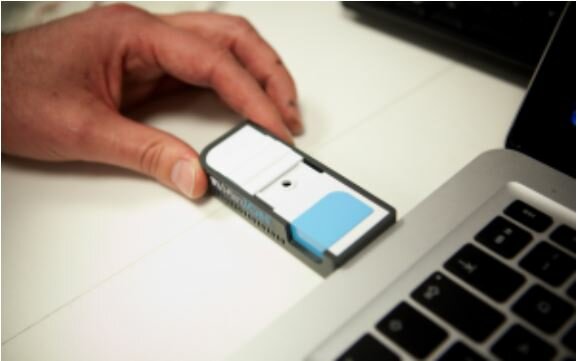At the annual Advances in Genome Biology and Technology (AGBT) conference held in Florida during 2012, there were many exciting announcements and developments in the world of DNA sequencing technology.
An especially cool piece of news came from the team at Oxford Nanopore, the stars of our piece on cluster sequencing, about their (then) brand new sequencing machine.
Much of the hype surrounded the focal point of the above image, a MinION. No, we don’t mean those banana loving yellow fools, but in fact a minuscule, disposable USB-key sequencer, capable of sequencing a whopping one billion base pairs of DNA from the comfort of your own lap.
Though it was initially a pricey purchase at between $500 and $900, its applications were seemingly endless. Being able to take some biological matter, combine it with a couple of chemicals, and then read its DNA was considered revolutionary. By no means affordable, it was the first tentative step into DNA experimentation at home.
A second, slightly less exciting but equally as intriguing announcement, was that of the GridION sequencing machine.
Built to read a great deal of DNA to scale up at humongous sequencing centers, it was able to read long strings of data that had previously been unthinkable (at least in a way as reliable as the human brain!)
What implications did these products have on those with a personal interest in genomics?
Simplified Sequencing
According to their estimations, one GridION machine, also referred to as a node, could read sequence as fast as 600 million base pairs an hour, the equivalent of 14GPB per day, and read high coverage (30x) human genome in less than six days.
Stacking up four nodes, you could therefore produce sequences working at a similar rate to Illumina’s high-end HiSeq 2500 machine.
At around $2200-$3600 for each genome, the machine was considered a new competitor in terms of throughput, data quality, and expenses, which at the time was a pretty sizeable achievement in comparison to the major sequencing companies from a smaller producer.
What was particularly clever about Oxford Nanopore’s inventions was that they avoided some of the difficulties traditionally found in DNA sequencing; each sequencer was tiny and stacked efficiently, with 20 units equating to the size of a traditional HiSeq at only a fifth of the footprint per genome.
Power consumption was also considerably reduced, and preparing DNA for sequencing takes moments as opposed to days of processing and much more expensive equipment. When people examine this company retrospectively, they will be able to clearly recognize their contribution to the simplification of genome sequencing.
This wasn’t just about reducing the cost - though they did, by a staggering 20% - but making at-home, outside the lab sequencing a possibility altogether. Nobody thinks about the price decrease in recent years, but everyone certainly remembers when Oxford Nanopore used a laptop computer to sequence rabbit DNA.
